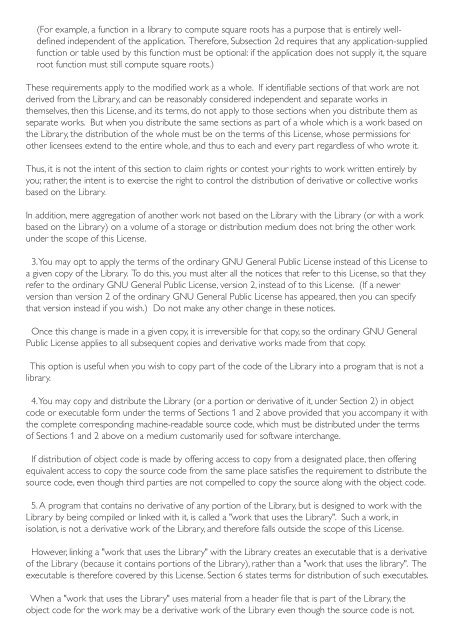Philips Streamium Microchaîne hi-fi sans fil - Mode d’emploi - DAN
Philips Streamium Microchaîne hi-fi sans fil - Mode d’emploi - DAN
Philips Streamium Microchaîne hi-fi sans fil - Mode d’emploi - DAN
You also want an ePaper? Increase the reach of your titles
YUMPU automatically turns print PDFs into web optimized ePapers that Google loves.
(For example, a function in a library to compute square roots has a purpose that is entirely wellde<strong>fi</strong><strong>ne</strong>d<br />
independent of the application. Therefore, Subsection 2d requires that any application-supplied<br />
function or table used by t<strong>hi</strong>s function must be optional: if the application does not supply it, the square<br />
root function must still compute square roots.)<br />
These requirements apply to the modi<strong>fi</strong>ed work as a whole. If identi<strong>fi</strong>able sections of that work are not<br />
derived from the Library, and can be reasonably considered independent and separate works in<br />
themselves, then t<strong>hi</strong>s License, and its terms, do not apply to those sections when you distribute them as<br />
separate works. But when you distribute the same sections as part of a whole w<strong>hi</strong>ch is a work based on<br />
the Library, the distribution of the whole must be on the terms of t<strong>hi</strong>s License, whose permissions for<br />
other licensees extend to the entire whole, and thus to each and every part regardless of who wrote it.<br />
Thus, it is not the intent of t<strong>hi</strong>s section to claim rights or contest your rights to work written entirely by<br />
you; rather, the intent is to exercise the right to control the distribution of derivative or collective works<br />
based on the Library.<br />
In addition, mere aggregation of another work not based on the Library with the Library (or with a work<br />
based on the Library) on a volume of a storage or distribution medium does not bring the other work<br />
under the scope of t<strong>hi</strong>s License.<br />
3. You may opt to apply the terms of the ordinary GNU Ge<strong>ne</strong>ral Public License instead of t<strong>hi</strong>s License to<br />
a given copy of the Library. To do t<strong>hi</strong>s, you must alter all the notices that refer to t<strong>hi</strong>s License, so that they<br />
refer to the ordinary GNU Ge<strong>ne</strong>ral Public License, version 2, instead of to t<strong>hi</strong>s License. (If a <strong>ne</strong>wer<br />
version than version 2 of the ordinary GNU Ge<strong>ne</strong>ral Public License has appeared, then you can specify<br />
that version instead if you wish.) Do not make any other change in these notices.<br />
Once t<strong>hi</strong>s change is made in a given copy, it is irreversible for that copy, so the ordinary GNU Ge<strong>ne</strong>ral<br />
Public License applies to all subsequent copies and derivative works made from that copy.<br />
T<strong>hi</strong>s option is useful when you wish to copy part of the code of the Library into a program that is not a<br />
library.<br />
4. You may copy and distribute the Library (or a portion or derivative of it, under Section 2) in object<br />
code or executable form under the terms of Sections 1 and 2 above provided that you accompany it with<br />
the complete corresponding mac<strong>hi</strong><strong>ne</strong>-readable source code, w<strong>hi</strong>ch must be distributed under the terms<br />
of Sections 1 and 2 above on a medium customarily used for software interchange.<br />
If distribution of object code is made by offering access to copy from a designated place, then offering<br />
equivalent access to copy the source code from the same place satis<strong>fi</strong>es the requirement to distribute the<br />
source code, even though t<strong>hi</strong>rd parties are not compelled to copy the source along with the object code.<br />
5. A program that contains no derivative of any portion of the Library, but is desig<strong>ne</strong>d to work with the<br />
Library by being compiled or linked with it, is called a "work that uses the Library". Such a work, in<br />
isolation, is not a derivative work of the Library, and therefore falls outside the scope of t<strong>hi</strong>s License.<br />
However, linking a "work that uses the Library" with the Library creates an executable that is a derivative<br />
of the Library (because it contains portions of the Library), rather than a "work that uses the library". The<br />
executable is therefore covered by t<strong>hi</strong>s License. Section 6 states terms for distribution of such executables.<br />
When a "work that uses the Library" uses material from a header <strong>fi</strong>le that is part of the Library, the<br />
object code for the work may be a derivative work of the Library even though the source code is not.
















